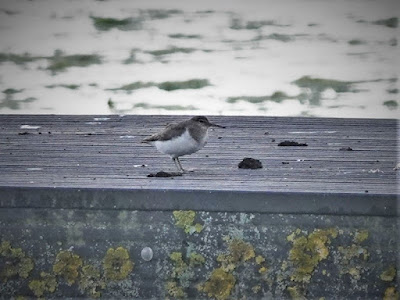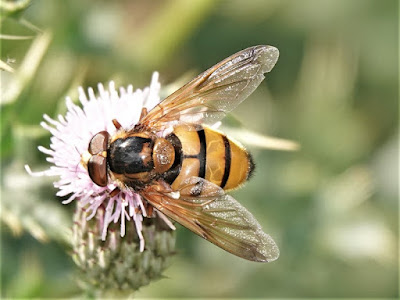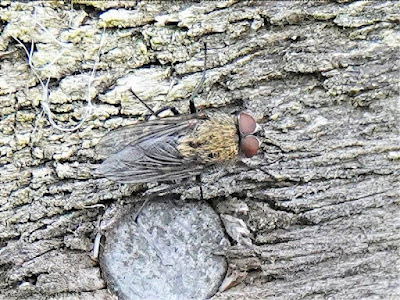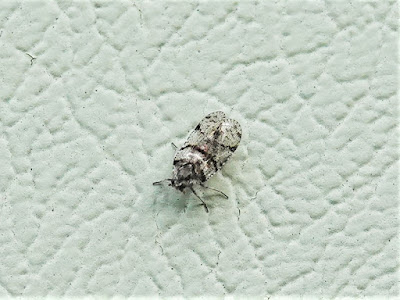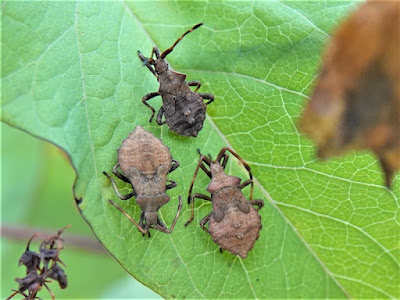12.0°C > 17.0°C: A few sunny intervals though much cloud from lifted local mist patches. Almost calm. Mostly very good visibility.
Sunrise: 05:13 BST
* = a species photographed today
$ = my first sighting of the species for this year
$$ = my first ever recorded sighting of the species in the area
Priorslee Balancing Lake: 05:00 – 06:15 // 07:30 – 09:55
(177th visit of the year)
Bird notes:
- six Canada Geese when I arrived: eventually 51. These six Canada Geese were with five Black-headed Gulls and two adult Lesser Black-backed Gulls gorging on waste food that had been thrown out of a vehicle parked in the Castle Farm Way lay-by. One of the Canada Geese was seen to consume a paper(?) wrapper. They all seemed oblivious to the passing traffic just a few feet away.
- also a single Canada Goose and then a group of 14 arrived very early leaving almost immediately. I have assumed that these returned later to be part of the 51.
- eight Greylag Geese eventually, seven of which arrived.
- two broods of eight very well-grown and seven small Mallard ducklings.
- all seven juvenile Great Crested Grebes from the four broods present and correct.
- a Common Sandpiper present throughout. This species has, so far, been scarce on Autumn passage.
- I did not see either Grey Heron arrive: one was being chased away when I first saw any.
- the Cetti's Warblers again eluded me. I could hear and see them jumping around in the vegetation but how many were involved?
- no Blackbirds heard singing today.
Bird(s) noted flying over here:
- 5 Canada Geese: a quintet inbound
- 101 Wood Pigeons
- 5 Lesser Black-baked Gulls again
- 133 Jackdaws
- 69 Rooks
Counts from the lake area:
- 51 Canada Geese: see notes
- 8 Greylag Geese: see notes
- 2 Mute Swans
- 21 (?♂) + 15 (2 broods) Mallard: see notes
- *12 + 4 (2 dependant broods) Moorhens
- 114 Coots
- ? + 7 (4 broods) Great Crested Grebes: again
- *1 Common Sandpiper
- 31 Black-headed Gulls: no juveniles
- 2 Lesser Black-baked Gulls
- 1 Cormorant: (near?) adult; arrived
- 2 Grey Herons: neither seen arriving; one chased away
Hirundines etc. noted:
None
Warblers recorded (the figure in brackets is birds noted singing):
- 2 (0) Cetti's Warblers
- 11 (2) Chiffchaffs
- 4 (1) Reed Warblers
- 4 (1) Blackcaps
Noted on the West end street lamp poles around-dawn:
Warblers recorded (the figure in brackets is birds noted singing):
- 2 (0) Cetti's Warblers
- 11 (2) Chiffchaffs
- 4 (1) Reed Warblers
- 4 (1) Blackcaps
Noted on the West end street lamp poles around-dawn:
Moths:
*1 Small Phoenix Ecliptopera silaceata
*1 Small Phoenix Ecliptopera silaceata
Spiders, harvestmen etc.:
1 Long-jawed Orb-web Spider Tetragnatha sp.
2 harvestmen Dicranopalpus ramosus/caudatus
Noted later:
I noted just one butterfly, one hoverfly and a few grass moths until c.10 minutes before I departed when the sun came out and there were suddenly insects galore.
1 Long-jawed Orb-web Spider Tetragnatha sp.
2 harvestmen Dicranopalpus ramosus/caudatus
Noted later:
I noted just one butterfly, one hoverfly and a few grass moths until c.10 minutes before I departed when the sun came out and there were suddenly insects galore.
Butterflies:
Large White Pieris brassicae
Green-veined White Pieris napi
Speckled Wood Pararge aegeria
Gatekeeper Pyronia tithonus
Large White Pieris brassicae
Green-veined White Pieris napi
Speckled Wood Pararge aegeria
Gatekeeper Pyronia tithonus
Moths
*3 Straw Grass-moth Agriphila straminella [was Straw Grass-veneer]
>20 unidentified grass moths, possibly all the same species
*3 Straw Grass-moth Agriphila straminella [was Straw Grass-veneer]
>20 unidentified grass moths, possibly all the same species
Bees, wasps etc.:
*$$ Furrow Bee Lasioglossum sp. perhaps Sharp-collared Furrow Bee L. malachurum
Common Carder Bee Bombus pascuorum
Buff-tailed Bumblebee Bombus terrestris
Common Wasp Paravespula vulgaris
*mason wasp Ancistrocerus sp.
*$$ Furrow Bee Lasioglossum sp. perhaps Sharp-collared Furrow Bee L. malachurum
Common Carder Bee Bombus pascuorum
Buff-tailed Bumblebee Bombus terrestris
Common Wasp Paravespula vulgaris
*mason wasp Ancistrocerus sp.
Hoverflies:
Marmalade Hoverfly Episyrphus balteatus
Tapered Dronefly Eristalis pertinax
Common Dronefly Eristalis tenax
*Tiger Hoverfly Helophilus pendulus [Tiger Marsh Fly; Sun Fly]
Common Twist-tail Sphaerophoria scripta [Long Hoverfly; Common Globetail]
*Pellucid Fly Volucella pellucens [Pied Plumehorn; Great Pied Hoverfly]
*Wasp Plumehorn Volucella inanis [was Lesser Hornet Hoverfly]
Marmalade Hoverfly Episyrphus balteatus
Tapered Dronefly Eristalis pertinax
Common Dronefly Eristalis tenax
*Tiger Hoverfly Helophilus pendulus [Tiger Marsh Fly; Sun Fly]
Common Twist-tail Sphaerophoria scripta [Long Hoverfly; Common Globetail]
*Pellucid Fly Volucella pellucens [Pied Plumehorn; Great Pied Hoverfly]
*Wasp Plumehorn Volucella inanis [was Lesser Hornet Hoverfly]
Dragon-/Damsel-flies:
none
none
Caddis etc. flies:
none
none
Other flies:
*Greenbottle Lucilia sp.
*$ Awkward Clusterfly Pollenia rudis
otherwise only unidentified fly species
*Greenbottle Lucilia sp.
*$ Awkward Clusterfly Pollenia rudis
otherwise only unidentified fly species
Bugs etc.:
*lacehopper Cixius nervosus
*Dock Bug Coreus marginatus
mirid bug Plagiognathus arbustorum [Leaf Bug; Common Nettle Flower Bug]
*lacehopper Cixius nervosus
*Dock Bug Coreus marginatus
mirid bug Plagiognathus arbustorum [Leaf Bug; Common Nettle Flower Bug]
Beetles:
7 Spot Ladybird Coccinella 7-punctata
Common Red Soldier Beetle Rhagonycha fulva
7 Spot Ladybird Coccinella 7-punctata
Common Red Soldier Beetle Rhagonycha fulva
Amphibians:
*Common Toad Bufo bufo
*Common Toad Bufo bufo
Spiders, harvestmen etc.:
none
none
Fungus:
*$ probable Common Jellyspot Dacrymyces stillatus
*$ probable Common Jellyspot Dacrymyces stillatus
New flowers for the year:
None
Moorhens usually keep their juveniles under cover until they are more or less independent so it was unusual to see a parent with three in tow.
At this point the sun came out and I was shooting against very bright light. A lone Common Sandpiper. After the first post-breeding arrival of a single on 30 June and a group of five on 03 July the Autumn passage has been very poor with today's being the next I have noted.
A moth not sitting at the best of angles with its folded wings away from me. There is just enough to see this is a Straw Grass-moth Agriphila straminella.
And a decent photo at last. At least 20 grass moths, likely all this species, flew away in to cover. By the way that is not a tree trunk it is clinging to, merely a small twig.
Google Lens gave the best suggestion for this as a Furrow Bee Lasioglossum sp. perhaps Sharp-collared Furrow Bee L. malachurum. Steven Falk's mammoth Field Guide suggests this species does not quite reach this far north. Using his ID key to this group of bees would require detailed examination of a specimen with a hand lens.
Taking advice from NatureSpot about the difficulty in identifying this group it will remain in the log as a "mason wasp Ancistrocerus sp."
I have tried hard but this does seem to be a "regular" Tiger Hoverfly Helophilus pendulus even though to my eyes it looks more tapered than usual and seems to have an extra band of yellow. Also known as the Tiger Marsh Fly, Sun Fly or The Footballer.
I have not seen one of these hoverflies for a few weeks. It is a Pellucid Fly Volucella pellucens which you may find elsewhere named Pied Plumehorn or Great Pied Hoverfly.
Despite its appearance like all hoverflies this Wasp Plumehorn Volucella inanis is quite harmless, happily feeding on nectar. Some species are more aggressive and love eating aphids. None stings or bites.
Trying to hide on the Teece Drive fence alongside one of the nails holding it together I found what is called an Awkward Clusterfly Pollenia rudis characterised by the short golden hairs on its thorax. I am not sure why it is "awkward". Perhaps because it is a cluster fly that is on its own?
I have placed this in my log as an honorary bug. It is a delicate lacehopper Cixius nervosus that I found on the wall of the Telford Sailing Club HQ.
One of two Common Toads Bufo bufo making their way along Teece Drive. The kerbing between the roadway and the Wesley Brook has an overhang which precludes the toads (and frogs) from climbing up and over. I tried to help but they move with surprising agility and don't want to be picked up.
(Ed Wilson)
In the Priorslee Avenue tunnel:
My first Common Carpet moth Epirrhoe alternata of the year. Not especially "common" as far as I am concerned. Its left wing looks a bit odd as the camera flash has cast a shadow on to the ceiling behind.
(173rd visit of the year)
Bird notes:
- two single Mallard ducklings each with a parent were noted.
- two very young juvenile Coot were noted in the middle of the water without any obvious parent looking after them..
- *a surprise from the ever-difficult Great Crested Grebes. A pair by the island were with at least two, possibly three, small juveniles. One of the two birds at the top end still sitting on a nest platform.
Bird(s) noted flying over here:
- 2 Jackdaws again
Noted on / around the water:
- 38 Canada Geese
- 22 Greylag Geese
- 6 Mute Swans
- 20 + 2 (2 broods) Mallard
- 19 (?♂) Tufted Duck
- 5 Moorhens again
- 96 + 10 (5 dependent broods) Coots
- *4 + 2 (1 brood) Great Crested Grebes
- 1 Black-headed Gull: adult
- *1 Grey Heron
Hirundines etc. noted:
- 2 House Martins
Warblers recorded (the figure in brackets is birds noted singing):
- 1 (0) Chiffchaff only
- 3 (2) Blackcaps
Noted around the area:
Moorhens usually keep their juveniles under cover until they are more or less independent so it was unusual to see a parent with three in tow.
A better angle but this one is worn.
Under the overhang at the top of the tallest street lamp I noted this Small Phoenix moth Ecliptopera silaceata. This must be a second generation as my previous sightings of this species were all in May.
Google Lens gave the best suggestion for this as a Furrow Bee Lasioglossum sp. perhaps Sharp-collared Furrow Bee L. malachurum. Steven Falk's mammoth Field Guide suggests this species does not quite reach this far north. Using his ID key to this group of bees would require detailed examination of a specimen with a hand lens.
Even if I can't make a specific identification Greenbottles Lucilia sp. are worth a photo from time to time.
Trying to hide on the Teece Drive fence alongside one of the nails holding it together I found what is called an Awkward Clusterfly Pollenia rudis characterised by the short golden hairs on its thorax. I am not sure why it is "awkward". Perhaps because it is a cluster fly that is on its own?
A Dock Bug Coreus marginatus party. This species seems to have been scarce this year.
Destroying the Teece Drive fence is this fungus I believe to be Common Jellyspot Dacrymyces stillatus.
(Ed Wilson)
------------------------------------------------------------------------------------------------------
In the Priorslee Avenue tunnel:
Moths: [28 species here before today; one addition]
*1 $ Common Carpet Epirrhoe alternata
*1 $ Common Carpet Epirrhoe alternata
Flies:
*1 undetermined cranefly
7 moth flies Psychodidae sp. [Drain Fly or Owl Fly]
14 midges of various species.
*1 undetermined cranefly
7 moth flies Psychodidae sp. [Drain Fly or Owl Fly]
14 midges of various species.
Arthropods:
2 White-legged Snake Millipedes Tachypodoiulus niger
2 White-legged Snake Millipedes Tachypodoiulus niger
Spiders, harvestmen etc.:
none
none
My first Common Carpet moth Epirrhoe alternata of the year. Not especially "common" as far as I am concerned. Its left wing looks a bit odd as the camera flash has cast a shadow on to the ceiling behind.
Cautionary tale. After editing the photo I asked Obsidentify what this cranefly was. It said "90% Tipula rufina". That did not seem right so I rotated and straightened the photo to the view you see here whence it now thought it was a Nephrotoma quadrifaria. It isn't that either. But I don't know what it is.
(Ed Wilson)
The Flash: 06:20 – 07:25
(Ed Wilson)
------------------------------------------------------------------------------------------------------
The Flash: 06:20 – 07:25
(173rd visit of the year)
Bird notes:
- two single Mallard ducklings each with a parent were noted.
- two very young juvenile Coot were noted in the middle of the water without any obvious parent looking after them..
- *a surprise from the ever-difficult Great Crested Grebes. A pair by the island were with at least two, possibly three, small juveniles. One of the two birds at the top end still sitting on a nest platform.
Bird(s) noted flying over here:
- 2 Jackdaws again
Noted on / around the water:
- 38 Canada Geese
- 22 Greylag Geese
- 6 Mute Swans
- 20 + 2 (2 broods) Mallard
- 19 (?♂) Tufted Duck
- 5 Moorhens again
- 96 + 10 (5 dependent broods) Coots
- *4 + 2 (1 brood) Great Crested Grebes
- 1 Black-headed Gull: adult
- *1 Grey Heron
Hirundines etc. noted:
- 2 House Martins
Warblers recorded (the figure in brackets is birds noted singing):
- 1 (0) Chiffchaff only
- 3 (2) Blackcaps
Noted around the area:
Butterflies:
none
none
Moths [on street lamp poles and in the grass] [59 species here before today: one addition]
*1 Riband Wave Idaea aversata nominate form
1 Swallow Prominent Pheosia tremula
*1 Black Arches Lymantria monacha
*1 $ Dun-bar Cosmia trapezina
*1 Riband Wave Idaea aversata nominate form
1 Swallow Prominent Pheosia tremula
*1 Black Arches Lymantria monacha
*1 $ Dun-bar Cosmia trapezina
Bees, wasps etc.:
Buff-tailed Bumblebee Bombus terrestris
Buff-tailed Bumblebee Bombus terrestris
Hoverflies:
none
none
Dragon-/Damsel-flies:
none
none
Caddis etc. flies:
*possible Pond Olive mayfly Cloeon dipterum
*possible Grouse Wing caddis fly Mystacides longicornis
*possible Pond Olive mayfly Cloeon dipterum
*possible Grouse Wing caddis fly Mystacides longicornis
Other flies:
a few different midges and flies
a few different midges and flies
Bugs:
*mirid bug Lygus sp.
*mirid bug Lygus sp.
Beetles:
none
none
Spiders, harvestmen etc.:
2 harvestman Dicranopalpus ramosus/caudatus
New flowers for the year:
2 harvestman Dicranopalpus ramosus/caudatus
New flowers for the year:
None
Taken on full zoom with the photo edited and cropped you may be able to make out three juvenile (humbug) Great Crested Grebes on a parent's back – certainly two are clearly(?) visible.
Very harsh light but I was intrigued to see a Grey Heron lying down. Have I ever seen one do that? More Coots are emerging from inside the island with two independent juveniles in front of the heron.
Only the second Riband Wave moth Idaea aversata of the nominate form I have seen this year with the filled-in area that gives the species its name. Apparently this form proliferates in southern Britain.
Not another! Yes: another Black Arches moth Lymantria monacha. My best year ever for seeing this species.
Possibly a Pond Olive mayfly Cloeon dipterum: a male with the turbinate eyes. I could not get Obsidentify or Google Lens to believe this was a mayfly.
Taken on full zoom with the photo edited and cropped you may be able to make out three juvenile (humbug) Great Crested Grebes on a parent's back – certainly two are clearly(?) visible.
A difficult light angle on my first Dun-bar moth Cosmia trapezina this year.

